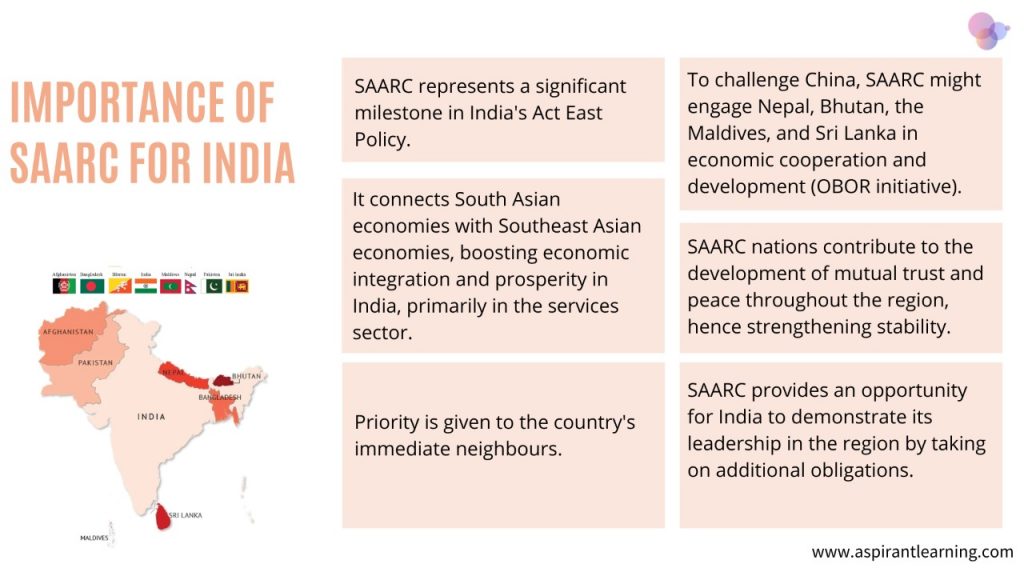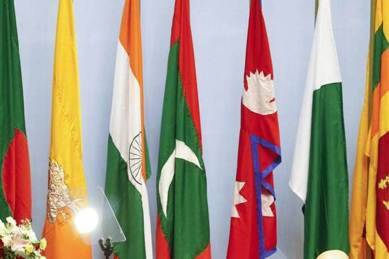News Highlight
South Asia appears to be the exception and the outlier to the most logical principle now — regional cooperation.
Key Takeaway
- According to a recent World Bank research on air pollution, South Asia accounts for over two million of the world’s nine most polluted cities’ annual premature deaths.
South Asia
- About
- South Asia is Asia’s southernmost region, characterised geographically and ethnically.
- The region includes Afghanistan, Bangladesh, Bhutan, India, Maldives, Nepal, Pakistan, and Sri Lanka.
- India’s concept of South Asian regional economic integration is built on increased intra-regional commerce, investment flows, and regional transport and communication connectivity.
- The two vehicles in this process are the South Asian Association for Regional Cooperation (SAARC) and India’s Neighbourhood First Policy.
South Asian Association for Regional Cooperation (SAARC)
- Overview
- SAARC was established in 1985 by seven states.
- Afghanistan proposed participation in SAARC in 2005 and formally applied for membership the following year.
- This organisation was founded on December 8, 1985, in Dhaka, Bangladesh, and its secretariat is situated in Kathmandu, Nepal.
- In addition, SAARC Potential Future Members – Turkey and Russia have applied to join SAARC.
- SAARC is made up of eight member countries and nine observer countries.
- Objectives
- Firstly, Improve the well-being and quality of life of the people of South Asia.
- Accelerate regional economic growth, social progress, and cultural development by allowing all people to live in dignity and reach their full potential.
- Subsequently, encourage and strengthen South Asian countries’ collective self-reliance.
- Help to build mutual trust, understanding, and appreciation for one another’s concerns.
- Encourage active collaboration and mutual help in economics, social sciences, culture, technology, and science.
- Additionally, increase collaboration with other developing countries.
- Increase their cooperation in international forums on issues of mutual concern.
- Furthermore, cooperate with international and regional groups that have similar goals and objectives.
- Areas of Cooperation Among SAARC Nations
- Agriculture and Rural Development
- Human Resource Development and Tourism
- Economic, Trade and Finance
- Social Affairs
- Environment, Natural Disasters and Biotechnology
- Education, Security and Culture and Others
- Information and Poverty Alleviation
- Energy, Transport, Science and Technology
Significance of SAARC
- SAARC is the world’s most densely populated region and one of its most fruitful.
- It accounts for 3% of the world’s land area, 21% of its people, and 3.8% (US$2.9 trillion) of the global economy.
- SAARC countries coordinate their efforts since they share common traditions, attire, food and culture, and political views.
- Poverty, illiteracy, starvation, natural disasters, internal conflicts, industrial and technological backwardness, low GDP, and poor socioeconomic situation are all issues that the SAARC nations face.
- These countries raise their living conditions by establishing common areas of development.
Challenges with SAARC
- The escalation of tensions and conflicts between India and Pakistan has significantly hampered SAARC’s prospects.
- SAARC meetings are held rarely.
- Instead of holding biennial meetings, SAARC member countries should meet annually.
- Because of the broad field of collaboration, energy and resources are redirected.
- The SAARC Free Trade Agreement (FTA) has not been implemented satisfactorily.

Conclusion
- Bangladesh, Bhutan, India, Maldives, Nepal, Pakistan, and Sri Lanka have distinct national identities inhibiting research on South Asia’s diversity.
- Contemporary South Asia aims to change this by researching and analysing the region’s current issues.
- Its purpose is to raise awareness that South Asia is more than the sum of its parts and that it matters to the region’s states, peoples, and the rest of the globe.
- Furthermore, address the region’s critical concerns from a regional and interdisciplinary viewpoint.
Pic Courtesy: Indian Express
Content Source: The Hindu



